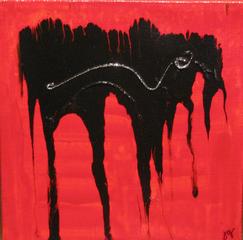WSP (Wearable Sculpture Project) - Anger in Art Movements
- artedelic
- Dec 7, 2015
- 2 min read
Generally, art movements aim to deconstruct whatever social norms came before it. The Renaissance's ascendancy emphasised individuality, as opposed to the gothic era's religious exclusiveness. The Impressionists put fleeting, momentary qualities over an object's intellectual form. Dada claims that all art is bullshit.
So you could say that all art movements are aggressive---they seek to destroy accepted values and replace it with their own ideas.
However, today I'd like to focus on art movements that are predominantly influenced by anger and its related themes: fear, unrest, and pain. The major art movements I'll be discussing today are Expressionism and Dadaism. If you'd like to see a more complete analysis of those movements, such as prominent artists, causes of movement, etc., you can read my posts here and here. This post, however, focuses on how anger is expressed in Expressionism and Dada.
EXPRESSIONISM
Expressionism is a modernist movement that started in Germany in the early 20th century. It seeks to represent the world from a solely subjective perspective, often at the expense of figurative clarity. The style reflects the widespread anxiety of the time, using distortion, unnatural colour palettes, and loose brushstrokes to express whatever the artist was feeling at the time.
The movement was triggered by social and political unrest. World War I was in the horizon, and Expressionism took a strong hold in Germany, where Hitler was rising to power and his Nazi ideas took hold. Artists needed a style that put the paranoid atmosphere before visual clarity. A common theme in Expressionist works is isolation and alienation, caused by the increasingly discordant relationship with the world. Women were often depicted as prostitutes to symbolise corrupt high power.
Trepidation dominated. There was a sense of claustrophobia in the air. Anger was born out of fear. Expressionist paintings tend to be vivid and violent, with jarring images.
DADAISM
Dadaism is a form of artistic anarchy born out of disgust for the social, political and cultural values (don't we all love it). It was aggressively anti-art, anti-war and anti-manifesto. Dada sees art as a bourgeois indulgence and should be destroyed along with the system. It was formed during the first World War as a reaction against the horrors of the war.
Dada favoured nihilism and often question existentialism. They favoured anti-aesthetics, placing objects (especially typography) randomly across a page. Chance is also a dominant theme. It sought to destroy what was seen as acceptable in art and life.
In post-war Berlin, however, the movement was more political and less anti-art. There, it was highly satirical and corrosive, using explosive typography, collages, photomontages and assemblage to target specific figures. Their originality sparked from Germany's political militanism. After WWI, Germany was "punished" by being forced to pay a hefty penalty, which launched the country into a deep economic depression. Dadaism was involved in the social upheavals and Spartakist revolution which broke out at the end of the war in Berlin.
RESOURCES
Expressionism in Art (c.1890-present) (visual-arts-cork.com)
Expressionism (faculty.cua.edu)
Dada (c. 1916-24) Nihilistic Anti-Art Movement (visual-arts-cork.com)























Comments